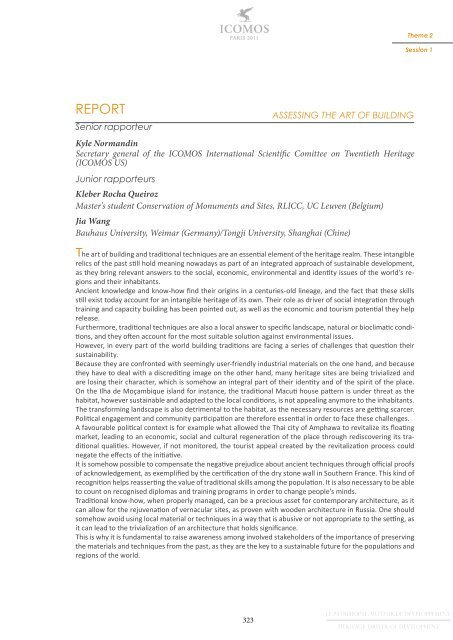PARTIE 2 - Icomos
PARTIE 2 - Icomos
PARTIE 2 - Icomos
You also want an ePaper? Increase the reach of your titles
YUMPU automatically turns print PDFs into web optimized ePapers that Google loves.
Theme 2<br />
Session 1<br />
REPORT<br />
Senior rapporteur<br />
ASSESSING THE ART OF BUILDING<br />
Kyle Normandin<br />
Secretary general of the ICOMOS International Scientific Comittee on Twentieth Heritage<br />
(ICOMOS US)<br />
Junior rapporteurs<br />
Kleber Rocha Queiroz<br />
Master’s student Conservation of Monuments and Sites, RLICC, UC Leuven (Belgium)<br />
Jia Wang<br />
Bauhaus University, Weimar (Germany)/Tongji University, Shanghai (Chine)<br />
The art of building and traditional techniques are an essential element of the heritage realm. These intangible<br />
relics of the past still hold meaning nowadays as part of an integrated approach of sustainable development,<br />
as they bring relevant answers to the social, economic, environmental and identity issues of the world’s regions<br />
and their inhabitants.<br />
Ancient knowledge and know-how find their origins in a centuries-old lineage, and the fact that these skills<br />
still exist today account for an intangible heritage of its own. Their role as driver of social integration through<br />
training and capacity building has been pointed out, as well as the economic and tourism potential they help<br />
release.<br />
Furthermore, traditional techniques are also a local answer to specific landscape, natural or bioclimatic conditions,<br />
and they often account for the most suitable solution against environmental issues.<br />
However, in every part of the world building traditions are facing a series of challenges that question their<br />
sustainability.<br />
Because they are confronted with seemingly user-friendly industrial materials on the one hand, and because<br />
they have to deal with a discrediting image on the other hand, many heritage sites are being trivialized and<br />
are losing their character, which is somehow an integral part of their identity and of the spirit of the place.<br />
On the Ilha de Moçambique island for instance, the traditional Macuti house pattern is under threat as the<br />
habitat, however sustainable and adapted to the local conditions, is not appealing anymore to the inhabitants.<br />
The transforming landscape is also detrimental to the habitat, as the necessary resources are getting scarcer.<br />
Political engagement and community participation are therefore essential in order to face these challenges.<br />
A favourable political context is for example what allowed the Thai city of Amphawa to revitalize its floating<br />
market, leading to an economic, social and cultural regeneration of the place through rediscovering its traditional<br />
qualities. However, if not monitored, the tourist appeal created by the revitalization process could<br />
negate the effects of the initiative.<br />
It is somehow possible to compensate the negative prejudice about ancient techniques through official proofs<br />
of acknowledgement, as exemplified by the certification of the dry stone wall in Southern France. This kind of<br />
recognition helps reasserting the value of traditional skills among the population. It is also necessary to be able<br />
to count on recognised diplomas and training programs in order to change people’s minds.<br />
Traditional know-how, when properly managed, can be a precious asset for contemporary architecture, as it<br />
can allow for the rejuvenation of vernacular sites, as proven with wooden architecture in Russia. One should<br />
somehow avoid using local material or techniques in a way that is abusive or not appropriate to the setting, as<br />
it can lead to the trivialization of an architecture that holds significance.<br />
This is why it is fundamental to raise awareness among involved stakeholders of the importance of preserving<br />
the materials and techniques from the past, as they are the key to a sustainable future for the populations and<br />
regions of the world.<br />
323<br />
LE PATRIMOINE, MOTEUR DE DÉVELOPPEMENT<br />
HERITAGE, DRIVER OF DEVELOPMENT

















